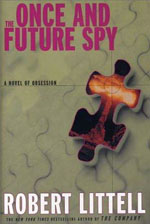
Book report: The Once and Future Spy
 Having recently read the magnificent spy epic The Company for the third or fourth time, I decided it was finally time to explore some of Robert Littell’s other works. So for no particular reason I picked his 1990 novel, The Once and Future Spy (which Mrs. Suit informs me is a King Arthur reference).
Having recently read the magnificent spy epic The Company for the third or fourth time, I decided it was finally time to explore some of Robert Littell’s other works. So for no particular reason I picked his 1990 novel, The Once and Future Spy (which Mrs. Suit informs me is a King Arthur reference).
While TO&FS is not nearly as engrossing or rewarding as The Company, it was fun and engaging nonetheless. Without giving too much of the plot away, the basic story goes like this: A CIA operative named Wanamaker is running an operation (code name Stufftingle) that may or may not be officially sanctioned by the agency, but is confounded by a leak. To find and stop the leak he brings in a retired and somewhat disgraced former Naval Intelligence officer, one Admiral J. Pepper Toothacher (yes, that’s the name they stick with) and his chauffeur/assistant/math whiz Huxstep.
The leak, as it turns out, is another CIA operative named Silas Sibley (aka The Weeder), who has personal and convoluted reasons for interfering with Wanamaker’s operation. But he quickly gets in over his head when the Admiral and Huxstep close in on him. The bulk of the novel details The Weeder’s attempts to save his own hide while still trying to put a stop to Stufftingle.
Had Littell just left it at that, TO&FS would have been a serviceable (albeit unremarkable) work of spy fiction. But he adds a story device that I rather enjoyed, although some may find it hackneyed. Sibley, as it happens, is also a Revolutionary War buff. And not just the war, but one participant in particular, whom he refers to as “Nate.” Sibley, who claims to be Nate’s descendant, is obsessed with Nate’s life and the circumstances leading to his early death.
As such, the novel alternates between the present and Sibley’s accounts of Nate’s activities during the war. Nate turns out to be Nathan Hale, widely regarded as America’s first spy. As the two stories progress, the similarities between Hale and Sibley become more obvious. The only question is whether the similarities are truth, coincidence, or merely the figment of Sibley’s overactive imagination.
So in truth, TO&FS is as much a work of historical fiction as it is spy fiction. And for a lot of the book, I was much more interested in Nate’s story than in Sibley’s. Littell incorporates enough historical fact into Nate’s life to lend it credibility, so the more fanciful portions seem plausible. The book seems a bit forced toward the end, but wraps up fairly nicely.
So I can recommend this book easily, and look forward to exploring more of Littell’s catalog.
People found this post by searching for:
- "the once and future spy", "stufftingle"